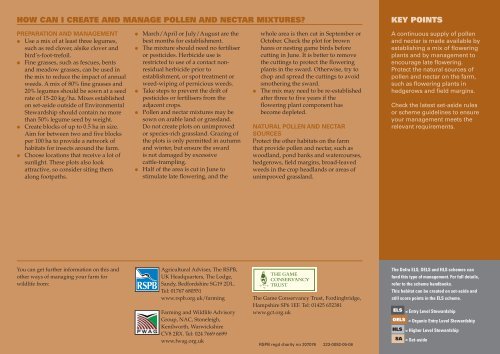Pollen And Nectar Mixtures - RSPB
Pollen And Nectar Mixtures - RSPB
Pollen And Nectar Mixtures - RSPB
Create successful ePaper yourself
Turn your PDF publications into a flip-book with our unique Google optimized e-Paper software.
HOW CAN I CREATE AND MANAGE POLLEN AND NECTAR MIXTURES?<br />
KEY POINTS<br />
PREPARATION AND MANAGEMENT<br />
● Use a mix of at least three legumes,<br />
such as red clover, alsike clover and<br />
bird’s-foot-trefoil.<br />
● Fine grasses, such as fescues, bents<br />
and meadow grasses, can be used in<br />
the mix to reduce the impact of annual<br />
weeds. A mix of 80% fine grasses and<br />
20% legumes should be sown at a seed<br />
rate of 15-20 kg/ha. Mixes established<br />
on set-aside outside of Environmental<br />
Stewardship should contain no more<br />
than 50% legume seed by weight.<br />
● Create blocks of up to 0.5 ha in size.<br />
Aim for between two and five blocks<br />
per 100 ha to provide a network of<br />
habitats for insects around the farm.<br />
● Choose locations that receive a lot of<br />
sunlight. These plots also look<br />
attractive, so consider siting them<br />
along footpaths.<br />
●<br />
●<br />
●<br />
●<br />
●<br />
March/April or July/August are the<br />
best months for establishment.<br />
The mixture should need no fertiliser<br />
or pesticides. Herbicide use is<br />
restricted to use of a contact nonresidual<br />
herbicide prior to<br />
establishment, or spot treatment or<br />
weed-wiping of pernicious weeds.<br />
Take steps to prevent the drift of<br />
pesticides or fertilisers from the<br />
adjacent crops.<br />
<strong>Pollen</strong> and nectar mixtures may be<br />
sown on arable land or grassland.<br />
Do not create plots on unimproved<br />
or species-rich grassland. Grazing of<br />
the plots is only permitted in autumn<br />
and winter, but ensure the sward<br />
is not damaged by excessive<br />
cattle-trampling.<br />
Half of the area is cut in June to<br />
stimulate late flowering, and the<br />
●<br />
whole area is then cut in September or<br />
October. Check the plot for brown<br />
hares or nesting game birds before<br />
cutting in June. It is better to remove<br />
the cuttings to protect the flowering<br />
plants in the sward. Otherwise, try to<br />
chop and spread the cuttings to avoid<br />
smothering the sward.<br />
The mix may need to be re-established<br />
after three to five years if the<br />
flowering plant component has<br />
become depleted.<br />
NATURAL POLLEN AND NECTAR<br />
SOURCES<br />
Protect the other habitats on the farm<br />
that provide pollen and nectar, such as<br />
woodland, pond banks and watercourses,<br />
hedgerows, field margins, broad-leaved<br />
weeds in the crop headlands or areas of<br />
unimproved grassland.<br />
A continuous supply of pollen<br />
and nectar is made available by<br />
establishing a mix of flowering<br />
plants and by management to<br />
encourage late flowering.<br />
Protect the natural sources of<br />
pollen and nectar on the farm,<br />
such as flowering plants in<br />
hedgerows and field margins.<br />
Check the latest set-aside rules<br />
or scheme guidelines to ensure<br />
your management meets the<br />
relevant requirements.<br />
You can get further information on this and<br />
other ways of managing your farm for<br />
wildlife from:<br />
Agricultural Adviser, The <strong>RSPB</strong>,<br />
UK Headquarters, The Lodge,<br />
Sandy, Bedfordshire SG19 2DL.<br />
Tel: 01767 680551<br />
www.rspb.org.uk/farming<br />
Farming and Wildlife Advisory<br />
Group, NAC, Stoneleigh,<br />
Kenilworth, Warwickshire<br />
CV8 2RX. Tel: 024 7669 6699<br />
www.fwag.org.uk<br />
The Game Conservancy Trust, Fordingbridge,<br />
Hampshire SP6 1EF. Tel: 01425 652381<br />
www.gct.org.uk<br />
<strong>RSPB</strong> regd charity no 207076 223-0092-05-06<br />
The Defra ELS, OELS and HLS schemes can<br />
fund this type of management. For full details,<br />
refer to the scheme handbooks.<br />
This habitat can be created on set-aside and<br />
still score points in the ELS scheme.<br />
ELS = Entry Level Stewardship<br />
OELS = Organic Entry Level Stewardship<br />
HLS = Higher Level Stewardship<br />
SA = Set-aside

















